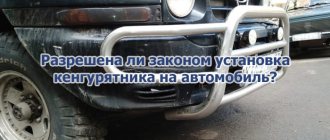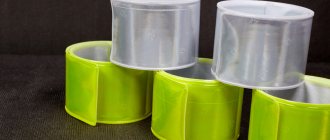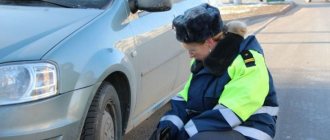general information
Special signals are used to notify other road users. Each of them has its own function; some are simply warning, while others require other road users to take some action.
The special signals specified in the third section of the traffic rules can only be used with the appropriate permission.
The list of structures entitled to use light and sound signals is established by the Government of the Russian Federation. In turn, officials of the established structures determine a specific list of cars on which means for providing light (sound) special signals will be installed.
“Flashing lights” in real traffic practice
Very often, the theoretical calculations of traffic rules do not fit into the practice of road traffic. And in order to achieve maximum safety, it is important to clearly and quickly make decisions when various “flashing lights” appear on the road.
Blue (or blue and red) flashing light
When a blue (or blue and red) flashing light appears, you need to be prepared for the fact that the driver of a special vehicle will deliberately and consciously ignore the requirements of traffic rules and all conceivable principles of traffic safety. Therefore, even in the absence of a special sound signal on such transport, it is advisable to give it priority. And don't overtake. And don't get ahead. It's calmer this way.
And if you approach such a stationary car, you should simply slow down, faithfully looking towards the “flashing lights”.
Yellow (or orange) flashing light
The appearance of such a “flashing light” should immediately alert an adequate driver. This indicates an unusual and dangerous situation on the road created by a special vehicle. It is advisable to stay away from him.
Types of special signals
The following types of special signals are used on the territory of the Russian Federation:
- Blue flashing light. May be accompanied by an audible signal.
- Blue and red flashing lights. May be accompanied by an audible signal.
- Yellow or orange flashing light.
- White-lunar flashing light. May be accompanied by an audible signal.
Such a list is determined by the third section of the Traffic Rules. The same section establishes the rules for the use of light and sound special signals.
Blue and blue-red
The blue flashing light can be used by:
- Emergency medical service.
- Police (including traffic police).
- Fire service.
- Emergency services.
- Prosecutor's office.
- Transportation service of the Central Bank and Gokhran.
- Traffic police department of the military department.
- Special service of the Ministry of Communications.
- Intelligence agency of the Ministry of Justice.
- FSO.
- FSB.
Of these, a red light flashing beacon can be used by:
- Police.
- FSO.
- FSB.
- Traffic police department of the military department.
In this case, the red beacon can only be used in conjunction with the blue one, and not instead of it.
You can turn on the blue (blue-red) special signal only when performing an important, emergency official task: catching a criminal, going to a sick person or to a fire scene, etc. In particular, you can use a blue-red beacon when accompanying an organized convoy of vehicles (or one vehicle). In this case, the escorted vehicles are equal to those with special signals turned on.
When using blue or blue-red beacons, the driver may not comply with traffic signals, road sign rules, markings, etc. He can also move in the oncoming lane of traffic. The only thing is that the driver is prohibited from violating the signals of the traffic controller, but when he sees a car with special signals turned on, he is obliged to immediately provide passage for him. The driver can use his advantage only on the condition that he is convinced of the safety of road traffic, since he is not relieved of responsibility for the accident.
Having seen blue and red beacons and heard a sound signal, other road users must ensure unhindered passage of special vehicles: pull to the side of the road, give way at a turn (intersection), etc.
Pedestrians and cyclists who are planning to cross the road at an equipped crossing must stop and wait for vehicles with special signals on to pass.
All drivers are prohibited from overtaking a car with their lights on. The exception is when the specified vehicle is stationary. In this case, drivers must slow down to such a speed that they can stop immediately (as a rule, a stationary car with blue lights on indicates danger ahead).
Yellow or orange
The orange flashing light can be used by the following vehicles:
- When performing construction work;
- When repairing the roadway;
- When loading, transporting and unloading broken (broken) vehicles;
- When transporting dangerous goods: flammable (gasoline, diesel fuel), large, toxic, etc.;
- When transporting an organized group of children;
- When accompanying vehicles transporting dangerous goods;
- When accompanied by an organized group of cyclists or pedestrians.
You can turn on the beacon directly when performing the specified actions.
Yellow and orange special signals do not give drivers any advantage over other road users. They only report the increased danger of the vehicle and draw the attention of other drivers to this. At the same time, when performing construction, repair and some other work, vehicles are allowed to deviate slightly from the requirements of several road signs and types of markings. For example, they may ignore a “No Stopping or Parking” sign.
Lunar white
Lunar-white flashing lights can only be installed on postal vehicles and vehicles transporting valuable cargo: money, precious metals, etc. Thus, this signal is used by collection service vehicles.
The white-lunar beacon turns on only if there is a direct danger of an attack on the specified vehicle (for example, when trying to rob). In this case, the driver does not receive an advantage over other road users: he must also comply with the requirements of road signs, markings and other traffic rules.
The white-lunar beacon serves to attract attention so that eyewitnesses can notice an attempt to attack a vehicle with a special signal. Along with the beacon, a special sound siren is always turned on.
Blue Bucket: Slow down
When the flashing light is on, it indicates some unusual situation on the road. And if a special vehicle is in a hurry somewhere, it must give way. This is fine. But then he reached his goal and positioned himself within the road with the flashing light turned on. What do the Rules say about this?
An ordinary driver, approaching such a vehicle, is obliged to reduce speed to such an extent as to be able to stop immediately if necessary. These may be requirements for providing assistance, participating in the preparation of a protocol, and much more.
Responsibility for illegal installation of special signals
As stated above, for unauthorized installation and use of means for sending special signals, administrative penalties may be applied to responsible persons in accordance with Article 12.4 of the Code of Administrative Offenses. Thus, paragraph 2 of the article provides for the following liability for the illegal installation of the special signals listed above:
- Individual – fine 5,000 rubles;
- The official who allowed the car to be used (provided that the car belongs to an organization) - a fine of 20,000 rubles;
- The legal entity that owns the car – a fine of 500,000 rubles.
Moreover, in all cases, in addition to the fine for flashing beacons, the removal and irrevocable confiscation of funds for issuing special signals is provided. The responsible person can be punished even if the driver did not turn on special signals, but was simply driving on public roads in the specified vehicle. If possible, the means for giving special signals will be confiscated right on the spot; if not, the car will be sent to the impound lot.
Rights of road users – what are the responsibilities of pedestrians and drivers?
Yellow (or orange) flashing light
Let us note right away: such a “flashing light” does not provide its owner with any advantage in movement. The question arises about the meaning of using a flashing light. And he is.
1. A yellow (or orange) flashing light warns other road users about the danger of the cargo being transported (due to its chemical properties, size or weight) or the danger during work carried out within the road.
2. When a yellow or orange “flashing light” is turned on on vehicles carrying out work on the maintenance, repair or construction of roads, as well as evacuating or moving vehicles, the driver can ignore a number of traffic regulations (subject to compliance with safety measures):
a) road marking regulations;
b) the requirements of road signs (with the exception of signs 2.2 “End of the main road”; 2.4 “Give way”; 2.5 “Driving without stopping is prohibited”; 2.6 “Take advantage of oncoming traffic”; 3.11 “Weight limit”; 3.12 “Weight limit per vehicle axle"; 3.13 "Height limitation"; 3.14 "Width limitation"; 3.17.2 "Danger"; 3.20 "Overtaking prohibited");
c) traffic regulations regarding paragraphs 9.4 - 9.8 (traffic “lane” rules), 16.1 (restriction of traffic on the highway).
When transporting large cargo and accompanying such transportation, the driver is only allowed to deviate from the requirements of road markings.
Thus, a yellow or orange “flashing light” allows, firstly, to warn about the danger of the vehicle; secondly, it grants some privileges to its owner, which are so necessary when performing professional duties.
Can special signals be used by an ordinary driver?
The legislation has established a list of services that can install blue and red-blue flashing lights.
According to paragraph 3.4 of the traffic rules, yellow or orange beacons can be easily installed on “regular” cars. These special signals are needed only to draw the attention of other drivers. For example, you can install an orange flasher on a car that accompanies a column of cyclists.
IMPORTANT! Special signals are installed only upon receipt of permission from the traffic police. Installing special signals without permission is illegal. Responsibility for this violation is assigned under Article 12.5 of the Code of Administrative Offenses of the Russian Federation.
Where to get permission
Permission for installation is carried out by putting a special mark on the vehicle registration certificate by an authorized representative of the State Traffic Inspectorate. However, the number of cars on which a stationary or removable lighting device can be installed is strictly calculated. An ordinary driver cannot install a blue or red-blue special signal on his car.
Arbitrary installation of a special signal is punishable by a fine of 5,000 rubles or deprivation of a driver's license for up to three months . And, of course, the flashing lights and siren will be confiscated.
What special vehicles must be allowed through?
Only cars with blue and red-blue flashing lights and sirens need to be allowed through. Vehicles with special signals of other categories do not have priority on the road.
How to give way correctly
The list of vehicles that must be allowed in cases where special signals are turned on is established by Decree of the President of the Russian Federation No. 365. These include:
- fire engines;
- Ministry of Emergency Situations;
- FSB;
- ambulance, resuscitation;
- Traffic police, road patrol, police vehicles;
- military prosecutor's office;
- government structures of the highest echelons of power.
Prohibited:
- Overtake vehicles with special signals turned on.
- If a vehicle with its beacons on is accompanying an organized transport convoy, then you cannot “wedge” into it.
- Obstruct the passage of a car with a flashing light and siren.
- If a vehicle with special signals has stopped (or is parked anywhere), then you need to approach it at minimum speed, and, if necessary, make a stop.
If a vehicle is moving along the roadway with red-blue or blue beacons and a siren on, then you need to reduce the speed and hug the edge of the road to increase the space for the vehicle to pass. It is worth remembering that you need to park your vehicle near buildings so that in case of an emergency (for example, a fire), the car can drive up.
What is the fine for not allowing a car with special signals to pass?
For failure to give priority to a car with red-blue or blue flashing lights on, as well as an audible signal, the driver will be fined from 3,000 to 5,000 rubles. In addition, as a punishment, a motorist can be deprived of his license for a period of three months to one year.
If the driver of the vehicle does not allow the ambulance to pass with its special signals turned on, which is why it does not reach the patient on time, then the punishment will be more severe. If a person dies, the violator of the law will face imprisonment or restriction of freedom for up to four years.
Any obstruction to the work of medical care is punishable by a fine of up to 80 thousand rubles. The punishment may be increased depending on the severity of the harm caused to the health of the person who needs the help of medical workers.
| Did not find an answer to your question? Call a lawyer! Moscow: +7 (499) 110-89-42 St. Petersburg: +7 (812) 385-56-34 Russia: +7 (499) 755-96-84 |
It is worth remembering that vehicles with a sound signal and blue and red-blue beacons on should always be allowed through. You cannot install such special devices on your cars. Vehicles with beacons of other colors do not have an advantage on the road.










